Trees of the Adirondacks:
Striped Maple (Acer pensylvanicum)
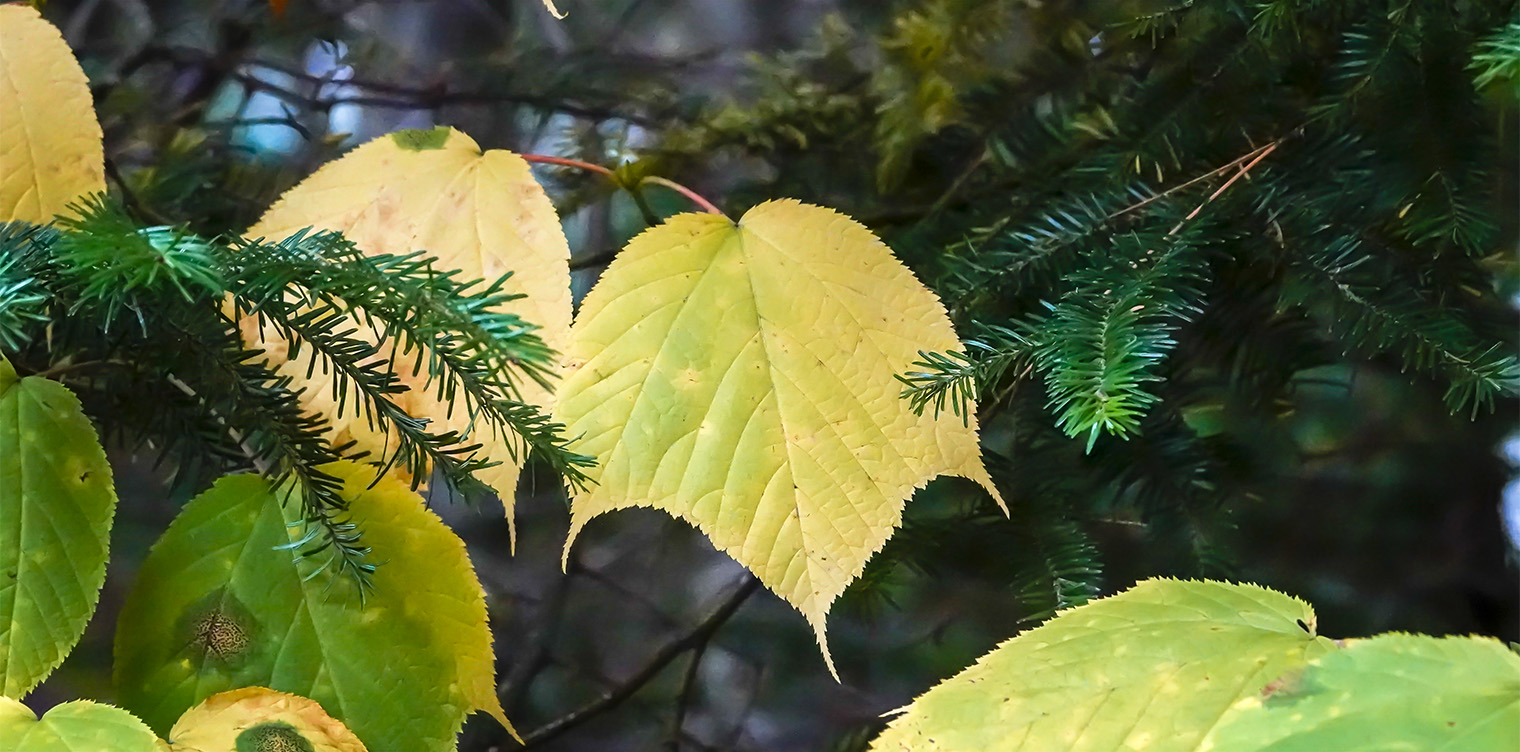
The Striped Maple (Acer pensylvanicum) is a small, deciduous understory tree or large shrub. This species can be found in both northern hardwood and mixed wood forests in the Adirondack Mountains of upstate New York.
Striped Maples are also known as Goosefoot or Goosefoot Maple – a reference to the fact that the leaf is shaped roughly like the foot of a goose. The Striped Maple is also known as Moosewood – a reference to the fact that the bark is consumed by moose in winter. The plant is also referred to as Pennsylvania Maple (a reference to the state of Pennsylvania, where the tree is a native species) and Snakebark Maple (a reference to its distinctive striped bark).
Identification of the Striped Maple
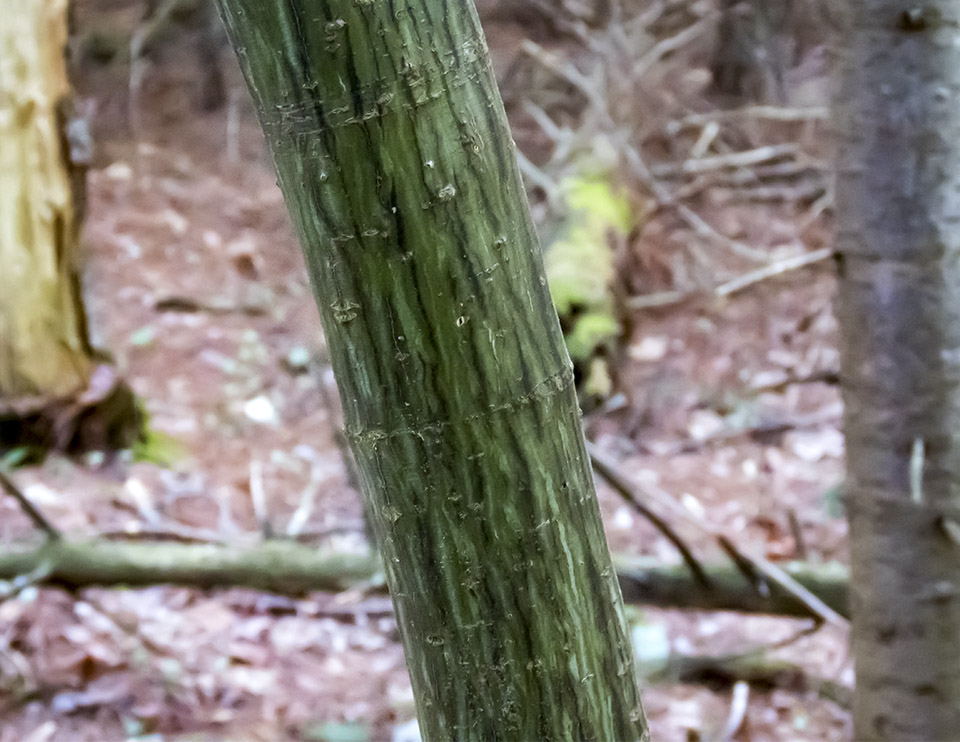
Striped Maple is a slow-growing understory tree which rarely grows over twenty or thirty feet tall and is often found growing as a shrub. The trunk is generally short and forked, usually divided into a few ascending, arching branches.
Striped Maple bark is smooth and green or greenish brown. It features long white or pale vertical lines. As the tree matures, the bark turns reddish-brown with dark vertical lines. The twigs are green and hairless, becoming striped with whitish lines.
Like other maples, Striped Maples have opposite, lobed leaves. The leaves of the Striped Maple are large, thin, and somewhat papery. They usually have three triangular, forward-pointing lobes, with a large central lobe. The margins of the leaves are finely toothed. The base of the leaf is rounded or slightly heart-shaped. Striped Maple leaves are a deep yellow-green and smooth above, turning yellow in autumn.
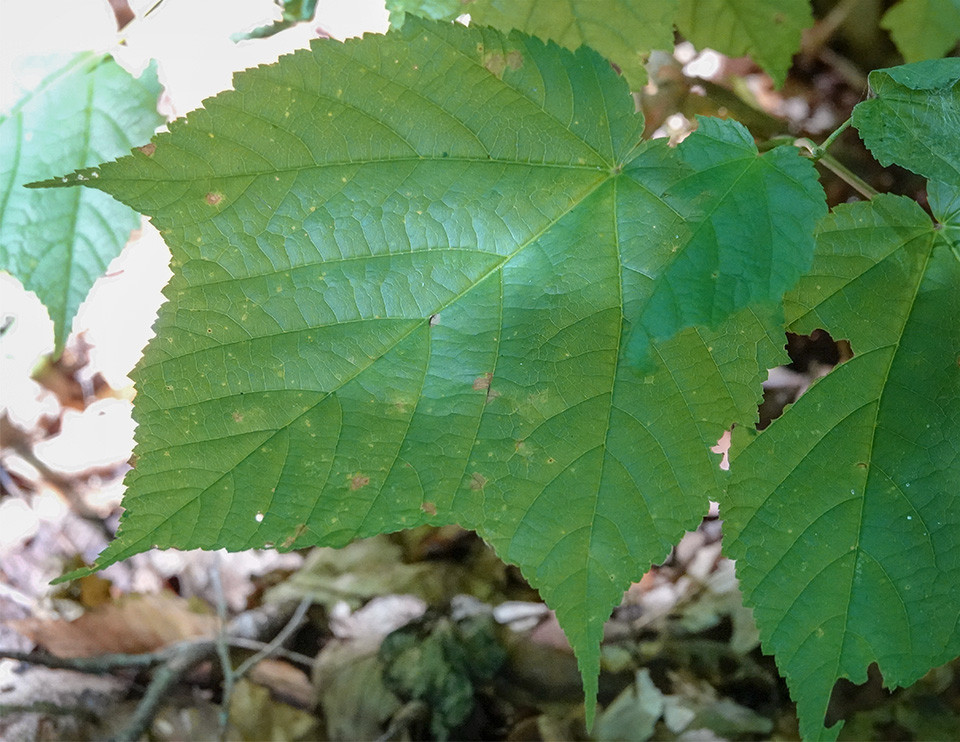
Keys to identifying the Striped Maple and differentiating it from other maples include its leaves, bark, and growth habit.
- Although Red Maple and Striped Maple, both have toothed leaf margins, Striped Maple leaves are more shallowly lobed than the deeply lobed leaves of Red Maple.
- The leaves of the Striped Maple differ from those of the Sugar Maple, which has several pointed tips on each lobe. By contrast, Striped Maple leaves are uniformly and finely double-toothed.
- Mountain Maple leaves resemble those of the Striped Maple. Both generally have three lobes with a heart-shaped or rounded base, although the Mountain Maple leaf sometimes has five lobes. However, Mountain Maple leaves are coarsely-toothed, contrasting with the tiny teeth of the Striped Maple leaf. Mountain Maple leaves are also somewhat smaller on average.
- The striped bark of the Striped Maple contrasts with that of the Mountain Maple, which is darker and reddish brown, without conspicuous vertical striping.
- The growth habit of the Striped Maple contrasts with that of both the Sugar Maple and the Red Maple. Both of these latter species mature into large trees, with a straight, single trunk, while the Striped Maple is a small tree or large shrub, often divided into several branches from near the base.
Striped Maple flowers in late spring or early summer, following leaf development. The flowers are small and greenish yellow, arranged in loose drooping clusters. In the Adirondack region, flowers usually appear in late May into early June.
The fruits are somewhat reddish in early development, changing later to tan. The fruits have widely spaced wings and are about 3/4 inch long, maturing in late summer and early fall. Fruits usually develop in September in the Adirondack Mountains.
Uses of the Striped Maple
The Striped Maple has limited uses. Its porous and fine-grained wood has occasionally been used by cabinet makers for inlay material. Native Americans reportedly used the wood to make arrows and the bark to make a beverage. Farmers in the American colonies and Canada reportedly fed their cattle both dried and green leaves in the winter; in the spring, when the buds had begun to swell, they turned their horses and cows into the woods to browse on the young shoots.
Striped Maple has no known edible uses and limited medicinal uses. Native Americans used the the Striped Maple to treat a variety of ailments including bronchial and kidney troubles, colds, and coughs.
Wildlife Value of the Striped Maple
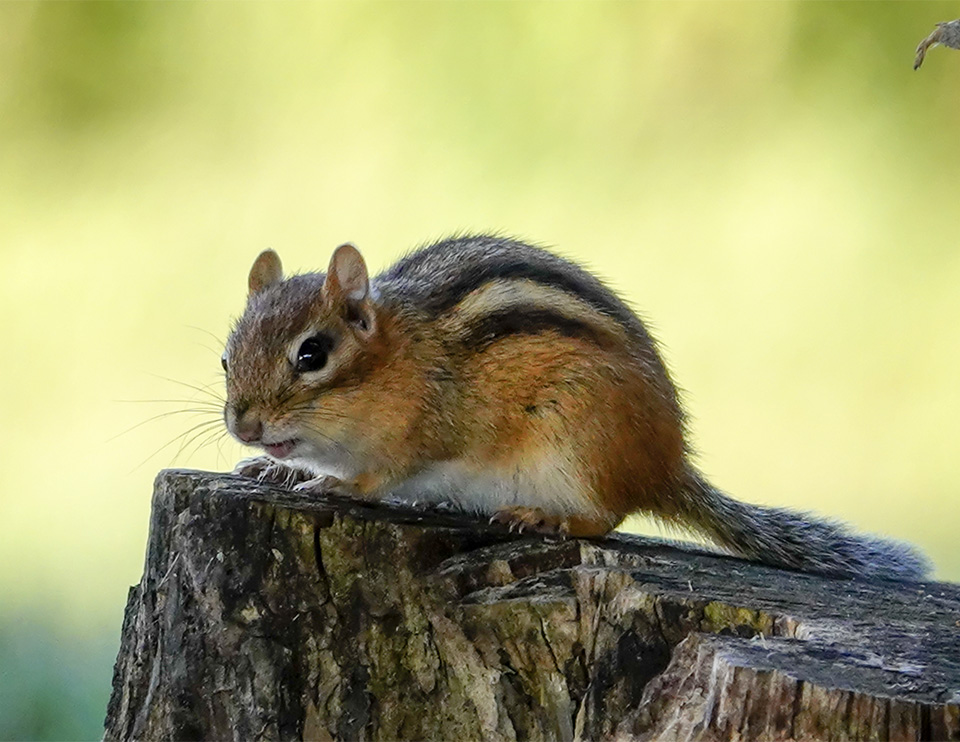
The Striped Maple is probably most important as a browse plant for wildlife. Its twigs are browsed by Snowshoe Hare. Red Squirrels, and Eastern Chipmunks eat the seeds. Striped Maple is frequently eaten by North American Porcupines. The Striped Maple also provides browse for White-tailed Deer and Moose, though the net energy derived from winter browse is relatively low. Ruffed Grouse consume the vegetative buds.
Striped Maples are also very useful to wildlife in that these small trees help create vertical diversity – a forest canopy with multiple layers. Multiple layers create a more balanced ecosystem providing both food and shelter for wildlife. For instance, Black-throated Blue Warblers prefer to nest in sites that offer a dense understory layer, including shrubs such as Hobblebush and small trees such as Striped Maple and Mountain Maple.
Distribution of the Striped Maple
This tree is widely distributed over the northeastern quarter of the United States and southeastern Canada, including most of the counties of New York State. The natural range of the Striped Maple extends from Nova Scotia west to southern Ontario, Michigan, and eastern Minnesota. The Striped Maple grows south to northeastern Ohio, Pennsylvania and New Jersey. It also grows in the mountains to northern Georgia.
In New York State, Striped Maples are present in most counties in the eastern part of the state. This species can be found in all counties in the Adirondack Park Blue Line.
Habitat of the Striped Maple
Striped Maple is a shade-tolerant species that grows best in dappled shade. It will not grow well in full sunlight. It prefers well-drained, acid soils. In contrast to Red Maple, Striped Maple is not tolerant of wet soils, and so this species is usually not found on the wetter marsh or boggy edges. Striped Maples are more commonly found in the drier and better-drained upland sites, growing as an understory tree in northern hardwood, mixed wood forests, and mountain conifer forests.
In the Adirondack Park, Striped Maple can be found in a several ecological communities, including:
Look for Striped Maple along the many trails throughout the Adirondack Park that wind through either northern hardwood or mixed wood forests.
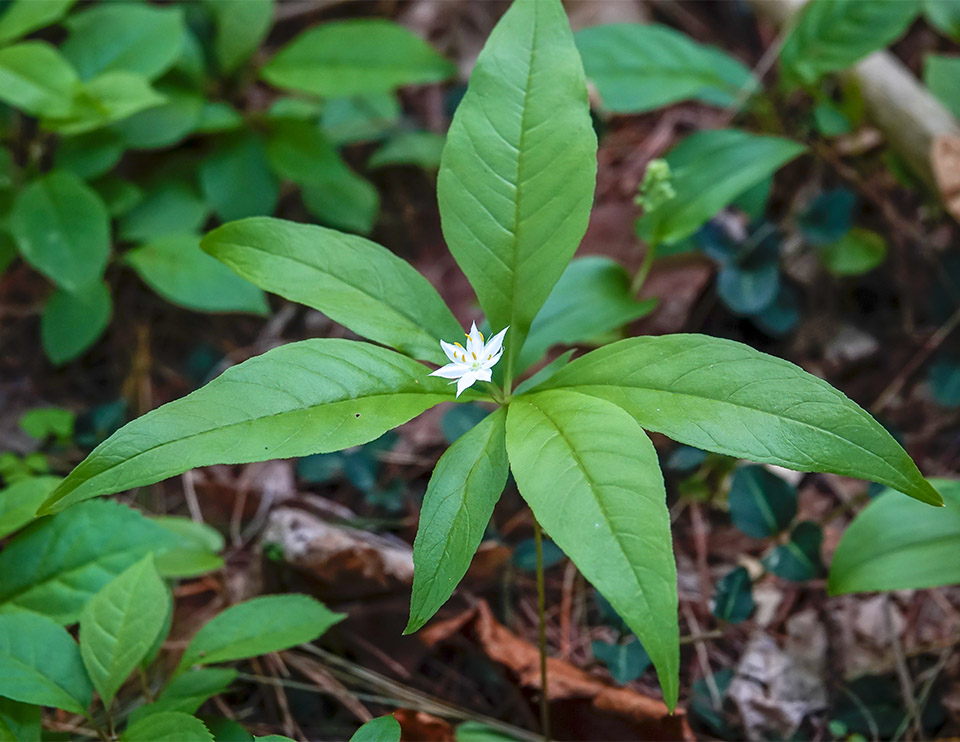
- In the hemlock-northern hardwood forest – a mixed forest that typically occurs on cool, mid-elevation slopes and on moist sites at the margins of swamps – look for Striped Maple growing under a canopy dominated by Eastern Hemlock. Hemlock may be codominant with Yellow Birch, Sugar Maple, Red Maple, Eastern White Pine, Black Cherry, or American Beech.
- The shrub layer includes Hobblebush, as well as saplings of canopy trees.
- The forest floor is often densely shaded, so the ground layer may be relatively sparse. Characteristic wildflowers include Canada Mayflower, Indian Cucumber-root, Wild Sarsaparilla, Partridgeberry, Common Wood Sorrel, Jack-in-the-Pulpit, and Starflower. Other wildflowers found growing in this ecological community include Foamflower, Purple Trillium, and Sessil-leaved Bellwort.
- Characteristic ferns include Christmas Fern, wood ferns (such as the Intermediate Wood Fern), and Northern Lady Fern, with New York Ferns and Hay-scented Ferns appearing in canopy gaps.
- Birds frequently found in this ecological community include the Blue-headed Vireo, Black-throated Green Warbler, and Blackburnian Warbler.
Adirondack Tree List
References
Michael Kudish. Adirondack Upland Flora: An Ecological Perspective (Saranac, New York: The Chauncy Press, 1992), pp. 42, 168, 248.
E. H. Ketchledge. Forests and Trees of the Adirondack High Peaks Region (Adirondack Mountain Club, 1996), pp. 143- 145.
Edwin H. Ketledge, "The Maples of New York," New York State Conservationist, Volume 16, Number 5 (April-May 1962), pp. 31-32. Retrieved 21 September 2020.
New York Flora Association. New York Flora Atlas. Striped Maple. Acer pensylvanicum L. Retrieved 9 March 2017.
United States Department of Agriculture. The Plants Database. Striped Maple. Acer pensylvanicum L. Retrieved 9 March 2017.
United States Department of Agriculture. Forest Service. Silvics of North America. Striped Maple. Retrieved 5 April 2019.
New York State. Department of Environmental Conservation. New York Natural Heritage Program. Ecological Communities of New York State. Second Edition (March 2014), pp. 107-108, 119-120, 121, 122, 123-124. Retrieved 17 October 2015.
New York Natural Heritage Program. 2019. Online Conservation Guide for Acidic Talus Slope Woodland. Retrieved 5 April 2019.
New York Natural Heritage Program. 2019. Online Conservation Guide for Beech-Maple Mesic Forest. Retrieved 5 April 2019.
New York Natural Heritage Program. 2019. Online Conservation Guide for Hemlock-Northern Hardwood Forest. Retrieved 5 April 2019.
New York Natural Heritage Program. 2019. Online Conservation Guide for Mountain Spruce-Fir Forest. Retrieved 5 April 2019.
New York Natural Heritage Program. 2019. Online Conservation Guide for Spruce Flats. Retrieved 5 April 2019.
New York Natural Heritage Program. 2019. Online Conservation Guide for Spruce-Northern Hardwood Forest. Retrieved 5 April 2019.
New York State. Adirondack Park Agency. Preliminary List of Species Native Within the Adirondack Park Listed Alphabetically by Scientific Name and Sorted by Habit. Volume 1. Updated 10.23.2006, p.4. Retrieved 26 January 2017.
Lady Bird Johnson Wildflower Center. Native Plant Database. Retrieved 23 January 2015.
University of Wisconsin. Trees of Wisconsin. Acer pensylvanicum. Retrieved 23 January 2015.
Online Encyclopedia of Life. Acer pensylvanicum. Retrieved 23 January 2015.
University of Michigan. Native American Ethnobotany. A Database of Foods, Drugs, Dyes and Fibers of Native American Peoples, Derived from Plants. Acer pensylvanicum. L. Striped Maple. Retrieved 9 March 2017.
Plants for a Future. Database. Retrieved 23 January 2015.
The Birds of North America. Black-throated Blue Warbler. Subscription Web Site. Retrieved 5 April 2019.
Michael Wojtech. Bark: A Field Guide to Trees of the Northeast (University Press of New England, 2011), pp. 90-91.
George A. Petrides. A Field Guide to Eastern Trees (Boston: Houghton Mifflin Company, 1998), pp. 54-55, 202-203.
George A. Petrides. A Field Guide to Trees and Shrubs (Boston: Houghton Mifflin Company, 1958,1972), pp. 96-97, 120-121.
John Kricher. A Field Guide to Eastern Forests. North America (Boston: Houghton Mifflin Company, 1998), pp. 72-75, 126-127, 437.
Gil Nelson, Christopher J. Earle, and Richard Spellenberg. Trees of Eastern North America (Princeton : Princeton University Press), pp. 622-623.
C. Frank Brockman. Trees of North America (New York: St. Martin's Press), pp. 214-215.
Keith Rushforth and Charles Hollis. Field Guide to the Trees of North America (Washington, D.C., National Geographic, 2006), p. 204.
National Audubon Society. Field Guide to North American Trees (New York: Alfred A. Knopf, 1980), Plates 255 and 623, pp. 574-575.
Allen J. Coombes. Trees (New York: Dorling Kindersley, Inc., 1992), p. 96.
William Carey Grimm. The Illustrated Book of Wildflowers and Shrubs (Mechanicsburg, Pennsylvania, 1993), pp. 496-497.
